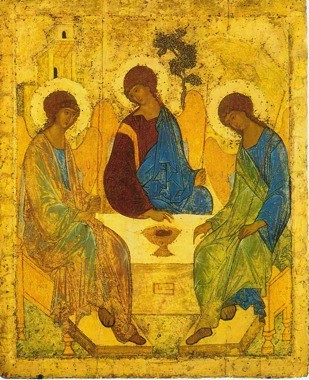
I have become reluctant to talk about G-d. It has been a gradual thing, but looking back over the last decade or so, a very clear development. I also talk much less to G-d. My prayers are more often than not silent—not even words in my head. Prayers for others are most often holding an image of them in the great mystery. (That's for another blog, another day.)
Today, in the church's calendar it is Trinity Sunday. Traditionally the day talk about G-d in the way Christians have understood G-d. So today I ponder my own reluctance.
Lest anyone think, "Oh dear! Andy's become an atheist," Or else, "Oh good! Andy's become an atheist," that's not the case. It's just that my understanding about G-d is different. How so?
It's mostly to do with the via negativa. Long ago theologians realized that G-d, in the very nature of what G-d is, is beyond any understanding or any description of what God is. You cannot say what G-d is, but you can say what G-d is not. It was this way of thinking that prompted the mystic Meister Ekhart to speak of the G-d beyond G-d. Even so, seriously religious folk often talk a great deal about G-d, as if they know about G-d, or that they truly do know G-d. I make no judgment about that. For me, I have been drawn to the apophatic (another way of saying via negativa). I seek enlightenment. I am becoming more reluctant to talk about what I do not know.
Still words are important. I am, after all, writing a blog. Words are helpful if we use them carefully. Bottom line: words are symbols—signs pointing beyond themselves. In religion folk often get caught up in words. Saying the right words. Judging those who use the wrong words. Thinking that the words are literally true. This causes all kinds of problems. As it is Trinity (and just happens to be Father's Day), I will mention the traditional use of Father to denote G-d. Such can be a useful denotation just as long as we remember that it is a symbol. Language about G-d has been termed analogous. G-d is a bit like this, but G-d is not this, for G-d is always beyond what we can say or think. Take Father language literally and we have masculinity built into what G-d is. Males bear a resemblance to G-d. Females do not. Males can represent G-d in a way that females cannot. Hence the patriarchy of traditional religions. That is one of the reasons why in the Lindisfarne Community we refer to G-d as Father-Mother. We have tried to remove sexism from our liturgies. But, here's the thing: G-d is no more literally a mother than she is a father. Words are symbols. It's a bit like this, but not literally this.
This is true also of the primary way Christians have referred to G-d: Holy Trinity, Father, Son and Holy Spirit, or as we say in Lindisfarne, Father-Mother, Child and Holy Spirit. This is deeply symbolic.
So, what does the symbol of Holy Trinity mean? I am tempted to end the blog here. For Trinity is mystery, if it is anything at all. Trinity is also none-sense. In logic it simply cannot be. Three persons who are not three but one, yet cannot be confused. Every attempt at explanation fails. It makes no sense. It's like trying to square the circle. Perhaps, that is the point. Whatever G-d is, is beyond any sense you might make of her. What is the symbol of Trinity? That G-d is ultimately mystery.
The symbol also speaks of relationality. Whatever G-d is, she is not aloof, alone, separate, unconcerned, disconnected, unempathic. The heart of G-d is relationship of love. There is nothing more profound than loving relationship, nothing more mysterious.
Here I do end the blog.
+Ab. Andy
- Posted using BlogPress from my iPad